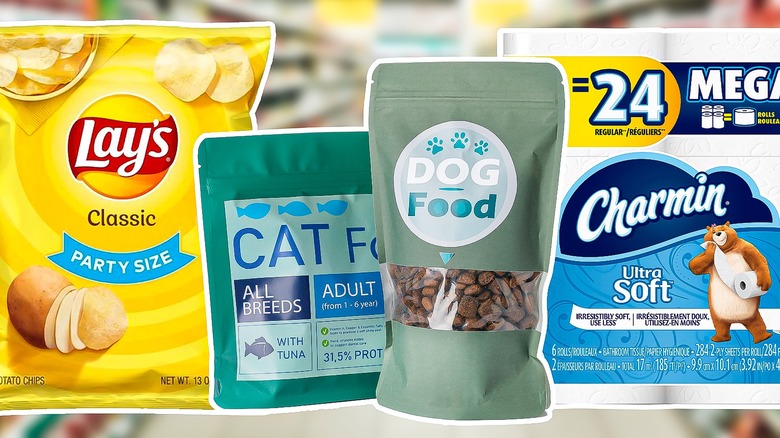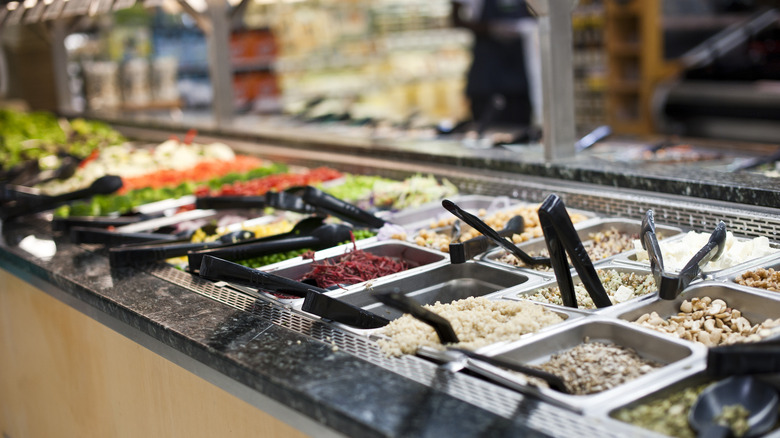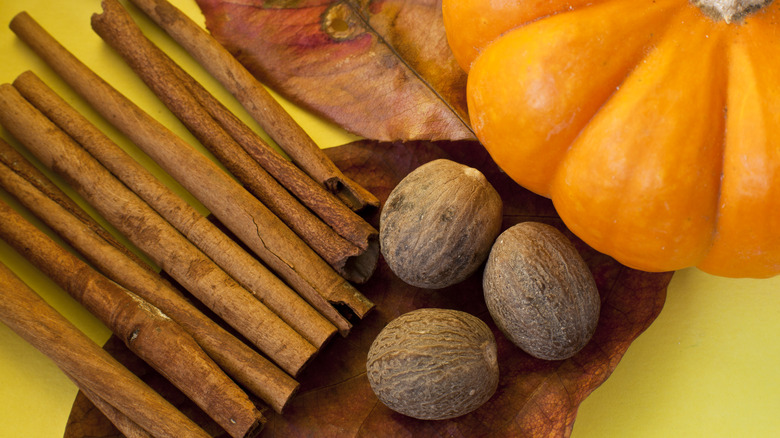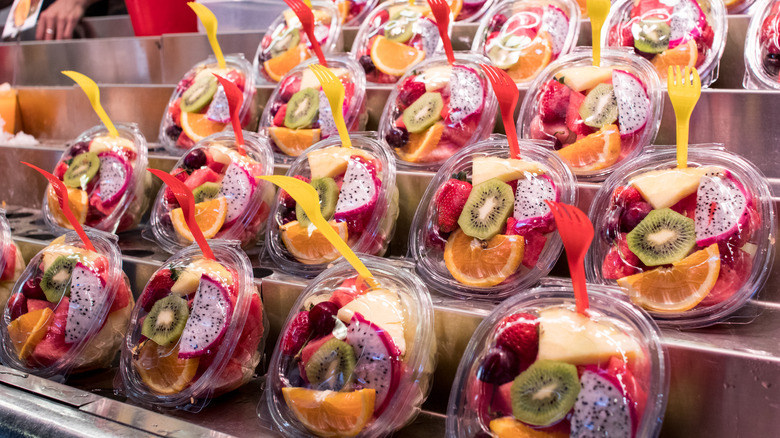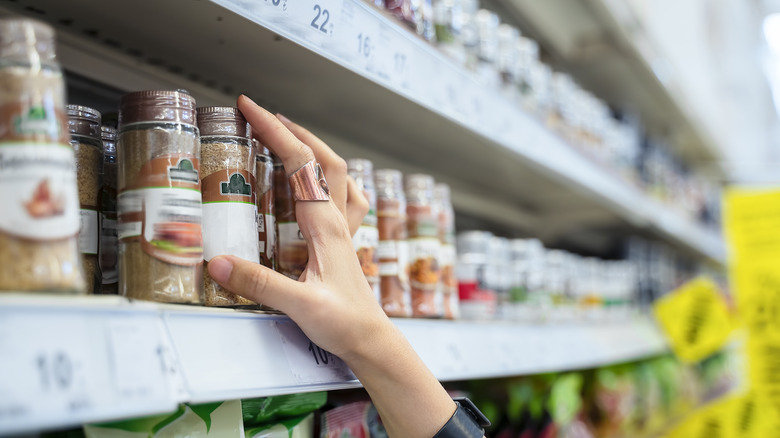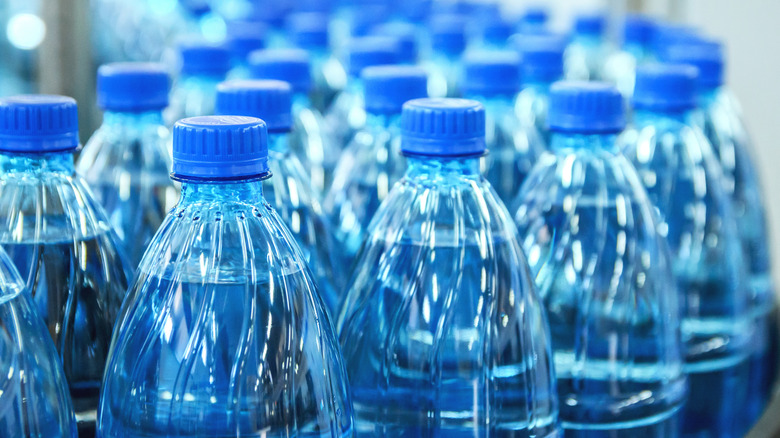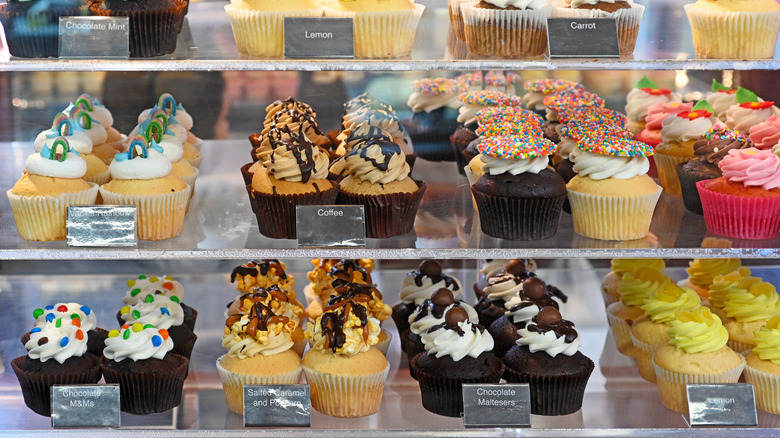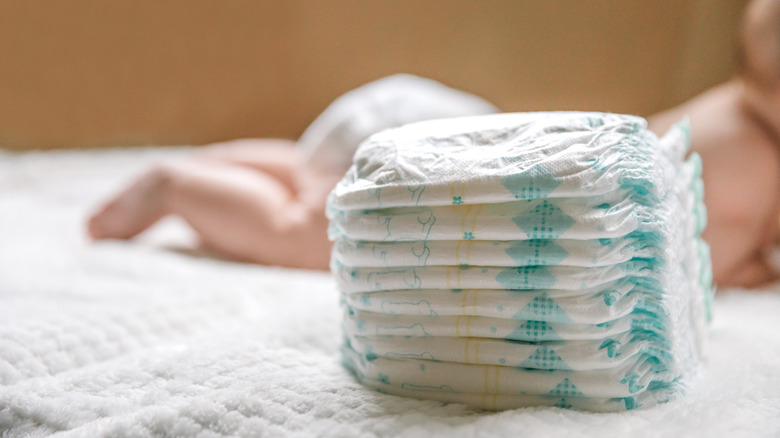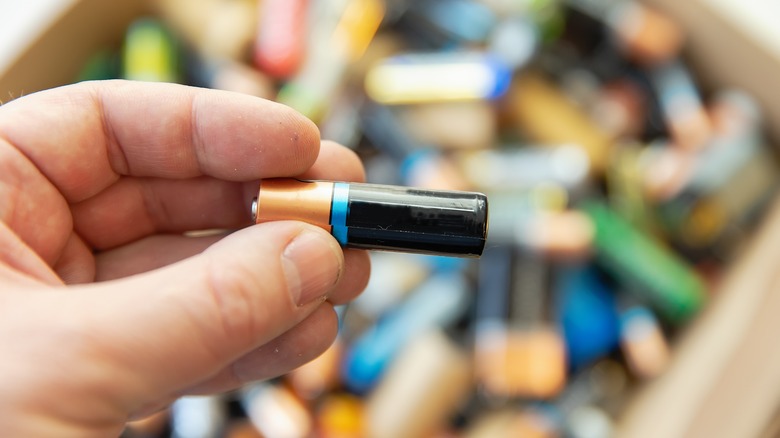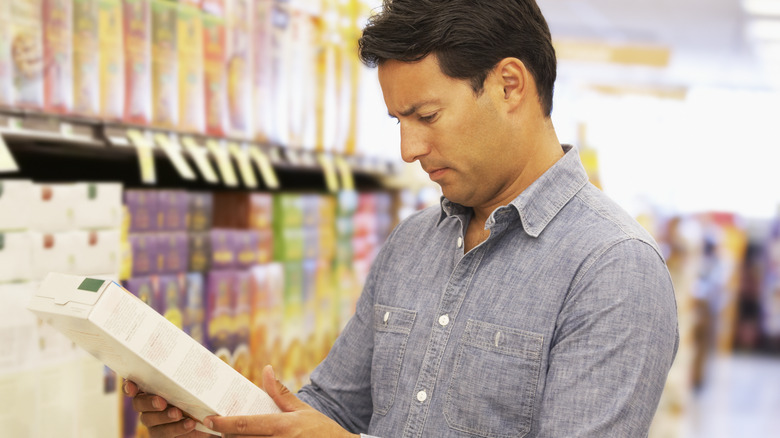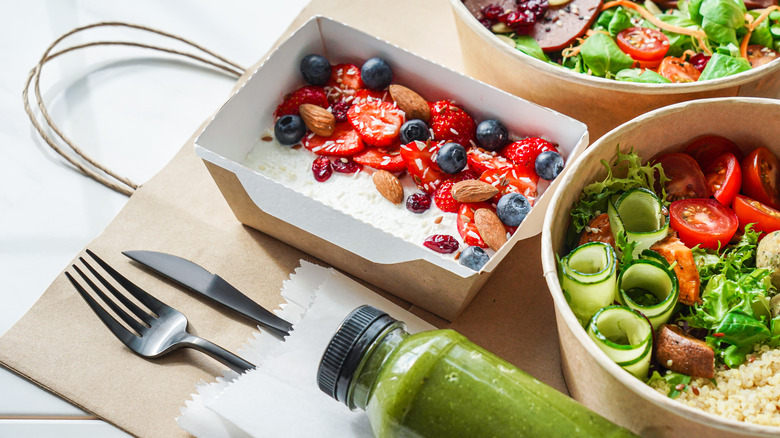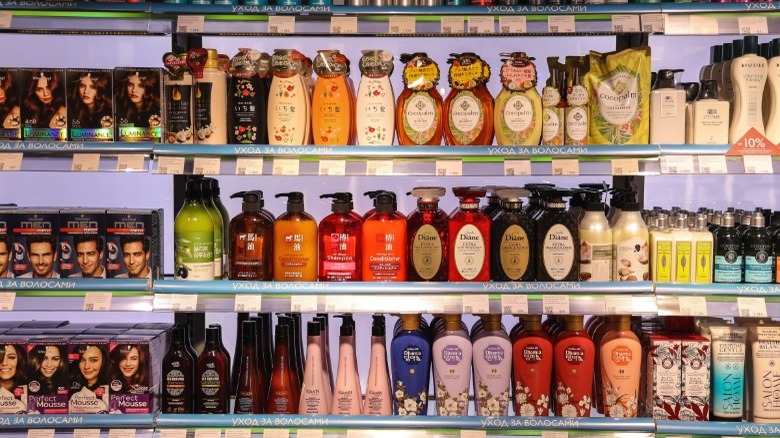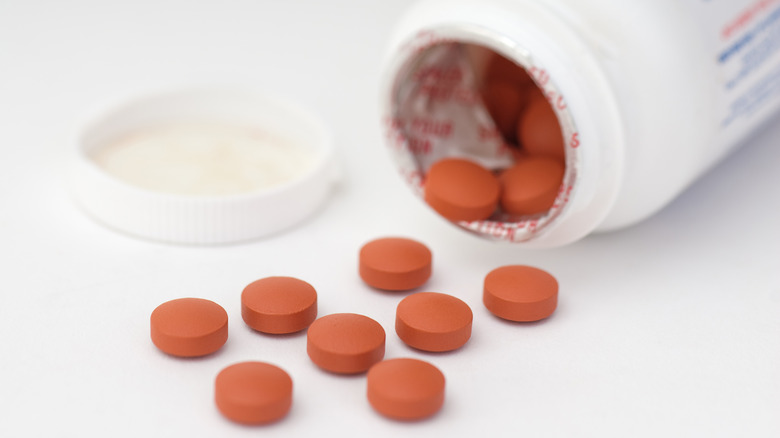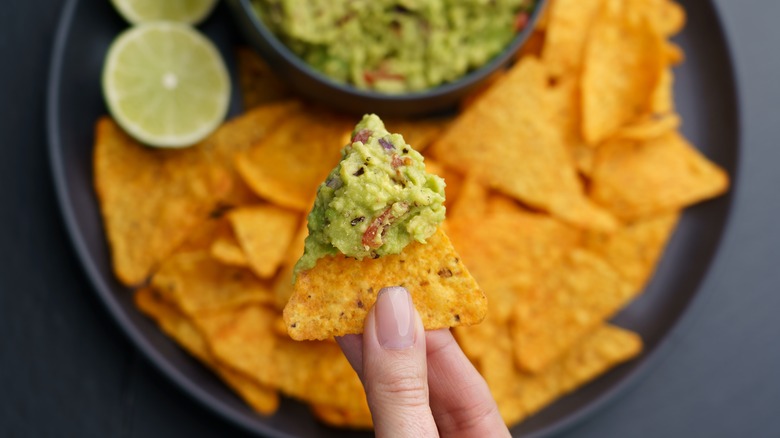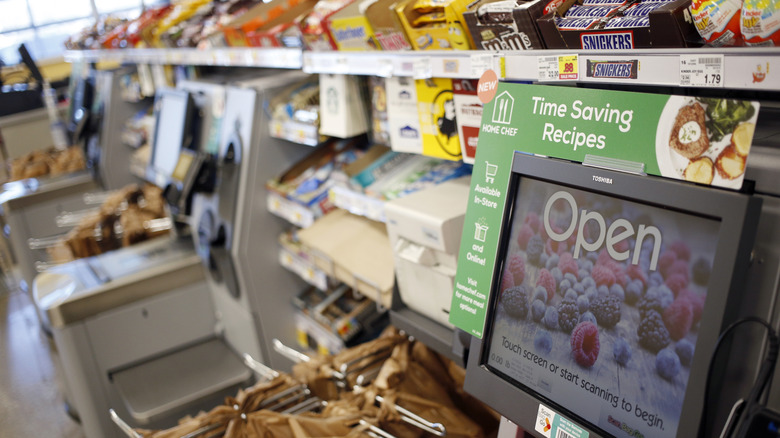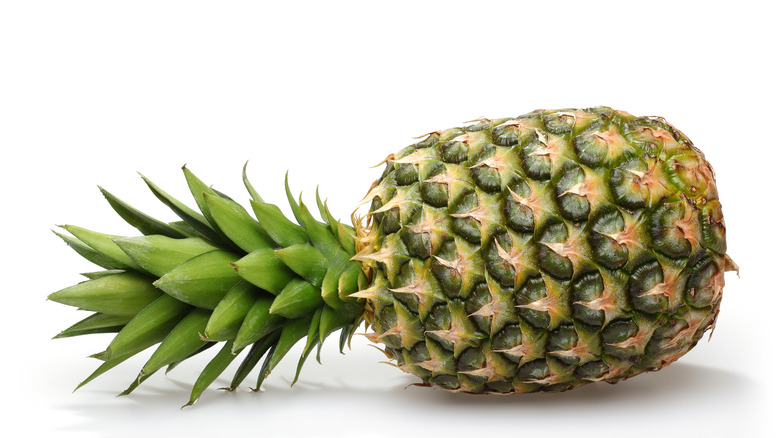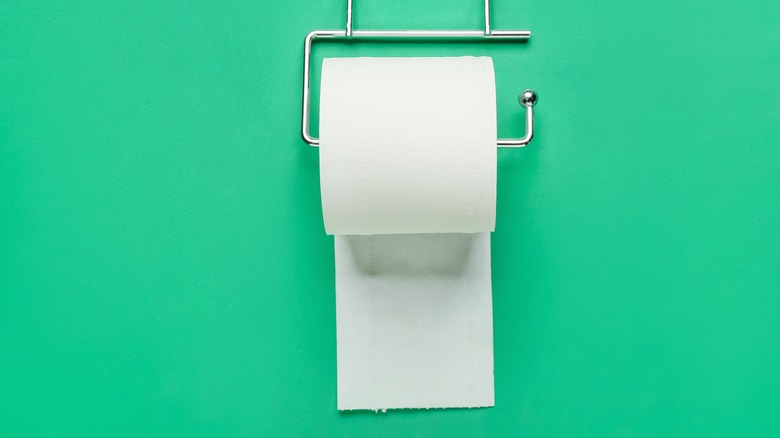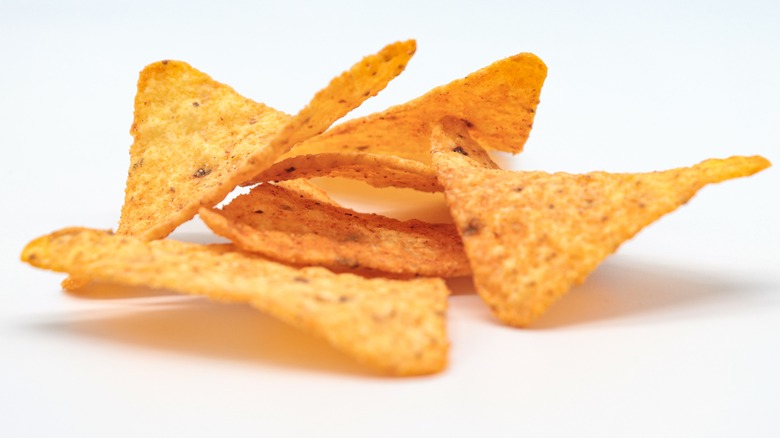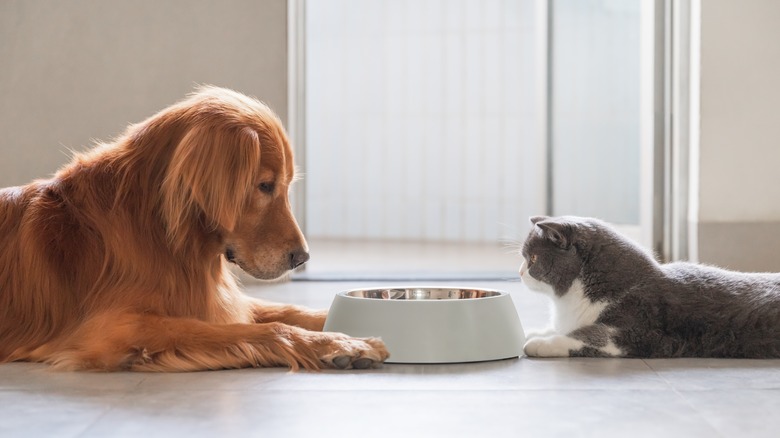23 Items You Should Never Buy At The Grocery Store
Grocery stores play a big role in our daily lives, but sometimes, despite their convenience and familiarity, they don't have our best interests at heart. With a profit margin of only 1% to 3% (per newspaper website Chron), they have to boost revenue where they can, and this is often done by marking up certain items more than others. Some products are worth the added expense due to the difficulty of procuring them elsewhere. Bread, for example, is a high profit-margin product for grocery stores because it's cheap to make, but that doesn't mean you'll want to beat them at their own game by spending hours each week kneading and baking your own.
There are plenty of items, however, that you can save a significant amount of money on if you avoid buying them from the grocery store. This is particularly true of everyday necessities and convenience items. With a little planning, you can mitigate these costs and save yourself thousands of dollars each year.
1. Food from the self-serve hot bar
Anyone who's been in a Whole Foods has felt at least two emotions upon encountering the hot bar: the thrill of seeing the abundance of mouth-watering options, and the sinking feeling of that eye-watering price tag. Hot bars are a big money-maker for grocery stores, whether it's the famously over-the-top version at Whole Foods or the more modest option at Kroger. According to Upside, grocery store hot bars can have a 50% to 70% profit margin before labor costs compared to the single-digit margins for most of the rest of a store's products.
There are, of course, ways to cheat the system when you're paying by the pound, such as opting for low-weight, high-reward items, but overall, it is much more affordable to cook a meal at home. It might even be cheaper to go to a restaurant. In a TikTok video with over a million views, user @via..li reveals that she spent a jaw-dropping $26 at the Whole Foods salad bar when she ran out of time to make lunch. "I could've ate out," she laments. "I could've literally did Doordash."
2. Anything labeled as pumpkin spice flavored
As soon as fall hits, you can expect to see your store shelves packed with every type of pumpkin spice-flavored product imaginable, from cream cheese to Spam. But while the fragrant spice might conjure nostalgic memories and get you in the fall spirit, it's costing you dearly. In 2022, MagnifyMoney found that Americans are spending an average of 14.1% more on pumpkin spice-flavored products compared to other flavors. The highest markup, for Trader Joe's pretzels, was 161% compared to the company's non-pumpkin spice-flavored version of the same product, according to the study. Whole Foods was the most consistent offender, with an average markup of nearly 28% on all pumpkin spice products.
Before you throw up your hands and produce your credit card, consider how easy it is to make your own spice blend at home. Most are a combination of cinnamon, ginger, nutmeg, and cloves or allspice. With a little tinkering, you can make your own mixture and add to whatever products you want, even Spam if that's what gets you in the autumnal spirit.
3. Pre-cut fruits and vegetables
Pre-cut fruits and veggies are a convenient option when you want to cook at home but are running short on time, yet it's worth resisting. Whether it's a single portion of sliced apples or a bag of chopped sweet potatoes, pre-cut produce can cost you five times as much as its uncut counterpart.
Take apples, for example. In Oakland, California, one pound of Pink Lady apples from Safeway will set you back $2.99, while a package of Signature Farms apple slices costs $6.40 per pound. If you're buying sweet potatoes from Walmart, whole potatoes cost $0.98 per pound, while a bag of cubed potatoes sells for $3.28 per pound. Those are steep markups, especially considering fruits and veggies are kitchen staples that you probably buy frequently.
If you want to avoid overspending on produce, set aside time during the week to pre-slice fruit and vegetables yourself. You can store them in containers in your fridge and use them just as you would use pre-cut produce from the store, but for a fraction of the price.
4. Name-brand spices
Spices are a quick, easy, and versatile way to elevate your cooking and baking, and you might think they're pretty cost-effective too. But while they cut out the hassle of chopping fresh herbs and buying costly condiments, they can take a toll on your wallet, especially if you're opting for name-brand products. If you're buying ground ginger from Whole Foods, for example, you could spend $2.89 per ounce for the store's own brand, 365, or $5.81 per ounce for Frontier's version.
If you're looking for smoked paprika, you can buy it at Walmart for only $0.97 per ounce from the store's Great Value brand or spend $2.45 per ounce for Frontier's version. McCormick's smoked paprika, meanwhile, is a whopping $6.67 per ounce. Given that there is no easy answer about whether higher quality spices really make a difference in your cooking, you're better off buying the generic brands.
If you really want to outsmart the markups and fill your spice rack for a fraction of the cost, go to your local health food store and buy them in bulk. For example, at Central Market in Austin, you can get ground ginger for $0.55 per ounce and paprika for $0.99 per ounce.
5. Bottled water
Bottled water is a notorious offender when it comes to markups (and environmental damage). Pop into your local convenience store, and you could be spending somewhere around $1 to $3 per bottle, or $10 if you're going for a premium option. While a few bucks isn't going to break the bank, it seems almost criminal to spend that much when you consider how much the water is actually worth. According to some number crunching by 20 Something Finance, you could fill 4,787 water bottles with tap water for just $2.10.
We know what you're thinking: What about the quality difference between natural spring water from the Alps and regular tap water? Well, despite the marketing, the difference between tap water and bottled water is not as significant as most of us want to believe. Bottled water carries risks of microplastics and is largely unregulated by the U.S. Food and Drug Administration, meaning that many companies escape the scrutiny leveled at firms producing other food and drink products. All tap water certainly isn't created equal, but bottled water, aside from the significant harm it poses to the environment, is not worth the astronomical markup.
6. Muffins and cookies
One of the most effective ways that grocery stores trick you into spending more is putting the bakery section near the entrance. With its mouth-watering smells of freshly baked bread, it jumpstarts your appetite and gives the store a sheen of freshness. This positioning is also a deliberate way to showcase some of the most high-profit products in the store. Baked goods are quick and easy to produce on-site, unlike items such as milk and produce, but they are also irresistible to shoppers and therefore ripe for marking up. Stroll through your local Trader Joe's or Kroger, and you'll find that $6 is enough to buy you a few muffins or a loaf of bread, not both.
Most of us don't have time to regularly bake bread, but cookies and muffins are a different story. Instead of sinking half your paycheck in the bakery section at Wegmans, why not stock up on baking essentials and make them at home? You can have a batch of delicious chocolate chip cookies (maybe even the best chocolate chip cookies) ready in under an hour and the bonus of having that delicious smell pervade your house.
7. Chocolate-covered strawberries
Cards, flowers, and chocolate-covered strawberries are the Valentine's Day trifecta. But while you're probably used to gazing in horror at the price tag on a bouquet of roses in the days leading up to the holiday, you may not notice exactly how expensive those artisan strawberries are. According to Leonelli Bakery, they are usually priced at $1 to $2 per strawberry, which, considering you'll be buying at least four and maybe closer to 10, is pretty steep.
One of the reasons it's worth saving your hard-earned cash on this romantic treat is that they are so easy to make. All you need is two ingredients and 20 minutes. If you're shopping at Publix in Miami, a box of six chocolate-covered strawberries costs $7.75 ($1.29 per berry). Compare this to buying a box of regular strawberries for $5.53 that contains at least three times as many berries, and 12 ounces of semi-sweet chocolate for $3.31. You could make three times as many chocolate-covered berries in less time than it would take you to grab some overpriced ones at the grocery store. If you don't believe us, try this Easy Chocolate-Covered Strawberry recipe and find out.
8. Diapers
There is no getting around it: If you have a baby, you need diapers. A lot of them. According to Consumers' Checkbook, the average infant uses about 2,700 diapers in the first year of life. Grocery stores know this and take advantage. If you're buying a 29-pack of size two Huggies from Safeway, it costs $0.41 per diaper. Compare this to Walmart's store brand, Parent's Choice, which costs a scant $0.13 per size two diaper, or Member's Mark from Sam's Club, which costs $0.16 per size two diaper. The difference is a matter of pennies, but when examined in a year-long timeframe, the difference is striking. A one-year supply of Huggies from Safeway would cost $1,107. In contrast, a year's supply of Parent's Choice would cost $351.
Grocery stores are able to mark up diaper prices because they know that when a baby needs changing, the parents have no choice but to grab the quickest option. If you're able to plan ahead, you can save hundreds of dollars a year buying in bulk from big box stores. Subscription services will also save you time and money if you prefer eco-friendly or premium brands. Amazon offers Prime members Seventh Generation diapers for $0.39 each and Honest Company diapers for $0.36 each, while Dyper and Hello Bello are also popular options.
9. Batteries
Batteries are one of those essential items that you don't think about until it's too late, like when you try to turn on the TV to watch your favorite show only to discover that the remote doesn't work, or when you're trying to trim that beard stubble before work but the electric shaver won't turn on. In these instances, you can't wait for Amazon to ship batteries or drive an extra 30 minutes to get to your nearest big box store. Supermarkets are gleeful at the dependence we have on these tiny power sources, and it's reflected in the prices.
You can find a packet of eight Duracell CopperTop AA Alkaline Batteries from Safeway for $1.12 per battery, or save money by buying them in bulk from Costco for $0.45 per battery for a package of 40. Batteries are expensive no matter where you buy them, but if you can afford to put out some money upfront and store them in your fridge, you could save 60% and not worry about missing your favorite show because the remote died or showing up to work with 2-day-old stubble.
10. Vitamins
About half the U.S. population takes supplements (per Harvard Health Publishing), but even though we want to believe they're improving our health and making up for nutrient gaps in our diets, studies suggest otherwise. Researchers from Harvard compared the effect of multiple popular supplements to placebos and found that they were largely identical. Fish oil, a supplement favored by 19 million Americans, showed no signs of helping to prevent heart attacks in at-risk people and even hinted at potential detrimental side effects from trace amounts of mercury and unhealthy fats.
Johns Hopkins Medicine did a similar study on multivitamins and found that they do not provide many of the health benefits they claim, such as reducing the risks of heart disease and cancer. There are exceptions, such as folic acid for women of childbearing age, but considering how long the vitamin aisle is at many grocery stores and how unregulated the industry is, you shouldn't feel obligated to spend your hard-earned cash on flashy marketing. It might be a different story if supplements were affordable, but the price tags can be dizzying. A jar of 140 multivitamins from Safeway costs close to $26, for example, while a box of 60 probiotic capsules costs more than $40.
11. Name-brand cereal
Cereal can feel personal due to its associations with childhood. Some people are devoted to Cap'n Crunch, while others prefer Lucky Charms or Kellogg's Frosted Flakes. What you're unlikely to find, however, are lifelong devotees of generic brands. There probably aren't many kids begging for another box of Walmart's Great Value Frosted Flakes, not because the quality is vastly different but because the friendly polar bear in ski goggles on the packaging just doesn't have the same magnetism or name recognition as Tony the Tiger.
These flashy name brands are priced accordingly, and while you might feel comfortable overlooking the discrepancy if cereal was just an occasional treat, it's a lot harder when it's an everyday essential as it is for many Americans. If you're buying a box of Honey Nut Cheerios for $6.88 per pound and a box of Lucky Charms for $6.88 per pound each week from Safeway, it would set you back $715 per year. Now compare that price to Walmart's generic brand, Great Value. If you purchased its version of Honey Nut Cheerios ($1.93 per pound) and Lucky Charms ($2.28 per pound), every week, it would cost about $219 per year. The brand may not hold a special place in your heart, but your bank balance is just fine with that.
12. Prepared food
Like the hot food bar, the prepared food section at grocery stores is a trap for hungry shoppers who are too tired or busy to make their next meal at home. A 2022 study by PYMNTS found that nearly 37% of shoppers had purchased prepared food products during their most recent trip to the grocery store, a 7% rise from nine months before. As options grow and Americans head back to the office, a well-balanced, ready-made meal is almost too convenient to resist.
When evaluating the finances, however, it might not be worth it. According to Jeff Campbell, a former store manager at Whole Foods who has a blog, supermarkets mark up prepared food by anywhere from 60% to 100%. It's no wonder that the PYMNTS study discovered that 43% of shoppers whose income exceeded $100,000 per year had purchased prepared food in their most recent grocery store outings compared with only 31% of those with incomes below $50,000. It may be convenient for your busy schedule, but prepared food can be pretty inconvenient for your credit card balance.
13. Name-brand hair and skin care products
We've all seen the ads for shampoo that will make your hair as glossy as a Krispie Kreme or moisturizer that will make your crow's feet magically melt away. But those supposed miracle workers cost a pretty penny, especially if you buy them from the grocery store. As with many day-to-day necessities, beauty products are more expensive at grocery stores because of the convenience, and buying in bulk from big box stores is a better option. A bottle of Nexxus Therappe Ultimate Moisture Moisturizing Shampoo from Kroger costs about $0.83 per ounce, for example, but only $0.46 per ounce if you buy it in a larger quantity from Sam's Club.
Beyond the cheaper options for name brands, you can simply spend less by purchasing generic brands. Not all generic brands are worth the money, but some are so beloved that they've reached cult-level status. Trader Joe's Daily Facial Sunscreen became an internet sensation for being a near-perfect replica of premium brand Supergoop's Unseen Sunscreen. While Supergoop was selling its product for $36, the Trader Joe's flawless dupe was a mere $9 (via Cheapism).
14. Greeting cards
The greeting card aisle is both a godsend and a money pit. When you're rushing to a birthday party and realize you forgot to get a card, those colorful rows of Hallmark messages are the only thing that can save you from yourself. And yes, they are priced in accordance with your desperation. A generic birthday card at Kroger costs about $5 (or close to $10 if you're opting for one of those fancy three-dimensional ones from Papyrus). In contrast, you could make one at home for the price of a sheet of paper and a few pencils.
The other option — which is a win-win for those who have a busy lifestyle and don't want to spend $5 on a card — is to buy in bulk from Amazon where you can find options as affordable as $0.40 per card. Regardless of whether someone you know has a birthday coming up, it's worth stockpiling a few options now so you don't find yourself panicking in the greeting card aisle 30 minutes before the party starts.
15. Gift wrap
Like greeting cards, gift wrap is an emergency product. You might think you've mastered the whole gift-giving thing by purchasing the perfect item, only to realize at the last minute that you don't have anything to wrap it with. Grocery stores reward your anxiety with a huge markup and a meager selection. Head to your nearest Safeway, and you'll find that a single gift bag costs about $4.99 and a few pieces of tissue paper will run you $2.69. That $7.68 probably won't break the bank, but it's a lot of spend on single-use packaging.
In contrast, Amazon has an abundance of options, including wrapping paper that you can use for multiple gifts. For about $14 you can get six sheets of paper in just about any design you can imagine. If you're in a hurry and need a brick-and-mortar store, Dollar Tree sells wrapping paper for as little as $1.25 a roll and gift bags for the same price. Even when you're in a hurry and can't wait for an Amazon delivery, Dollar Tree, Target, and Walmart are much better options than the grocery store.
16. Over-the-counter medicine
Over-the-counter medicines like Tylenol and NyQuil might not seem that expensive considering how miraculous they are when you need them, but they are high-profit items for grocery stores. You can get a container of 80 Advil Liqui-Gels from Walmart for $10.12 compared with $11.49 from Kroger and $14.99 from Safeway. Such a price increase from supermarkets is modest enough to not turn customers away but large enough to give them a hefty profit over time.
These prices are put to shame, however, when compared to generic brands of the same medication. Companies for name-brand over-the-counter drugs make flashy claims about their unique formulas and specific functions, but scientists have found that, despite claims of being fast-acting or being able to target specific types of pain, name-brand ibuprofen was identical to generic brands (via The Guardian). And yet, you pay a premium for the marketing. The 200 tablets of Advil containing 200 milligrams of ibuprofen costs $19.79 from Target. The same product and quantity from a generic brand at the same store costs $5.49.
17. Guacamole
No potluck or dinner party is complete without guacamole, but it can be intimidating to make yourself. What seems like a simple combination of avocado, cilantro, onion, lime juice, and tomatoes can require a lot of chopping and some wizardry to balance the flavors. This is where ready-made guacamole comes in. It can be a lifesaver when you're headed to a party and need to bring an appetizer, but it can also make your grocery bill pretty steep.
In 2019, CNBC calculated that the ingredients for homemade guacamole cost only about $0.20 per ounce while pre-made guacamole cost about $0.40 per ounce. On top of this price differential is the fact that the flavor of store-bought guacamole doesn't hold a candle to the freshly made kind. So the next time you're at the grocery store, add the ingredients to your cart and try this recipe for quick and easy guacamole. Once you try it, you'll never go back to the pre-packaged alternative, even without the markup.
18. Anything in the checkout line
Checkout lines are engineered to coax money from you. We all know we don't need an extra stick of gum or bottle of hand sanitizer, but it doesn't stop us from buying them. Americans spend about $5.5 billion on checkout items per year, according to a 2015 report from the Center for Science in the Public Interest. This accounts for only 1% of a grocery store's total sales, but 1.3% of its profits, illustrating that this area of the store is a high-margin goldmine for retailers.
Supermarkets use your psychology against you in the checkout aisle, placing items there that you probably didn't have on your shopping list but can't resist by the time you see them. As reported by Lifehack, candy and other junk foods are strategically positioned in the checkout aisle because stores know that by the time you reach the end of your shopping trip, your brain will be too tired from all the decision-making you've done throughout the store to resist. It's worth cutting out the extra expense and the calories by simply ignoring the mind games and sticking to your list.
19. Magazines
When you're standing at the checkout silently begging the people in front of you to finish unloading their cart, you might find yourself casting a glance at the magazines. Tabloids, fashion, current events, and fitness converge in this area of the grocery store, and the temptation to learn more about one of the cover stories might lead you to toss a magazine in your cart. You may not realize it, but that extra four or five dollars is a huge markup. You could spend $6.99 on a single issue of People at checkout, or subscribe to the magazine and get each issue delivered to your door for $1.75.
Similarly, a subscription to Vogue costs $1 per issue in the first year compared to the $7.99 cover price you'll spend on one issue at the grocery store. You're better off going home and reading the cover story on the internet or purchasing a subscription and maximizing the amount of content that you get for your money.
20. Organic produce that wouldn't have pesticides anyway
For those who try to buy organic produce wherever possible, grocery bills can be steep. While the price differential between organically grown and conventionally grown fruits and vegetables may be only a dollar or two, it adds up when you're purchasing enough to get you through a week's worth of meals. For some, the added expense is worthwhile, but there is a way to stick to your desire for clean produce and save money at the same time.
Every year, the nonprofit Environmental Working Group releases a list of the fruits and vegetables that are grown using the least amount of pesticides. If you keep on top of the Clean 15, you can save money by purchasing conventionally grown options instead of organic ones. Avocados are at the top of the list, followed by sweet corn, pineapple, onions, and papayas. Sweet potatoes, mushrooms, and carrots also made the list in 2023. For a simple comparison, a bag of four Hass avocados from Kroger costs $2.69, while an organic bag costs $3.69. A 10-ounce bag of frozen sweet corn costs $1.49 compared to $3.29 for its organic counterpart. And yellow onions cost $0.99 per pound while organic ones cost $1.49 per pound. If you bought these items at the grocery store, you'd save an average of $1.10 on each one if you purchased the non-organic options instead.
21. Toilet paper
Most people don't waste much thought on toilet paper until they need it, which is why grocery stores are able to sell it at a high-profit margin. When you run out, you'll buy it from whichever retailer is closest, and that is often your local supermarket. If you buy a 30-roll package of Charmin Ultra Soft from Safeway, it will cost you $1.17 per roll. If you purchase the same product from Sam's Club in a package of 32, it only costs $0.79 per roll. Buying generic brand products can also save you money. A 30-roll package of Great Value toilet paper from Walmart costs $0.67 per roll.
If you want to cut a trip to the store altogether, you can take advantage of a subscription service. Amazon offers deep discounts with its Subscribe and Save scheme, allowing you to purchase its AmazonBasics toilet paper for $0.80 per roll. Toilet paper is the last thing you want to think about and the last thing you want to run out of. It pays to buy in bulk or set up a subscription.
22. Single-serving snacks
Single-portion snacks are a double-edged sword. On one hand, they prevent you from eating a party-sized bag of your favorite chips. But on the other hand, they cost a lot more than a larger bag of the same product. Whether you're buying chips, popcorn, or trail mix, it pays to buy in bulk, even if it means you have to exercise greater impulse control.
At Safeway, a 1-ounce bag of Lays potato chips costs $0.70 when purchased in a pack of 10, while a 13-ounce bag costs only $0.46 per ounce. Similarly, at Kroger, nine 1-ounce bags of Goldfish cost $0.89 per ounce, while a 30-ounce bag costs only $0.35 per ounce. These single-serving bags might theoretically help with portion control, but if we're being honest, who's going to settle for a 1-ounce bag of anything? For the sake of both your appetite and your wallet, you're better off getting the family size.
23. Pet food
Everyone knows having children is expensive, but few people are prepared for the financial toll that pets take. Aside from vet visits, beds, and toys, food is a daily expense that doesn't come cheaply. Luckily, there are ways to cut costs by choosing your retailer wisely. A 2019 survey from Consumers' Checkbook found that Walmart's prices on the most popular brands of dog food were 17% lower than average, while Sam's Club's prices were 26% lower than average. Wegmans and Giant were the most affordable grocery stores for pet food, while the prices at Safeway were 22% higher than the average.
Some pet owners opt to save money by using subscription services like Chewy or Amazon, though the prices are still slightly higher than big box stores. A 31.1-pound bag of Purina ONE Natural SmartBlend costs $1.58 per pound from Wegmans, $1.50 per pound from both Amazon and Chewy when purchased as a subscription, but only $1.30 per pound when purchased from Sam's Club in a 40-pound bag. It may be easier to use a subscription service, but if you want the absolute lowest price, stores like Sam's Club, Walmart, and Target beat the competition.
